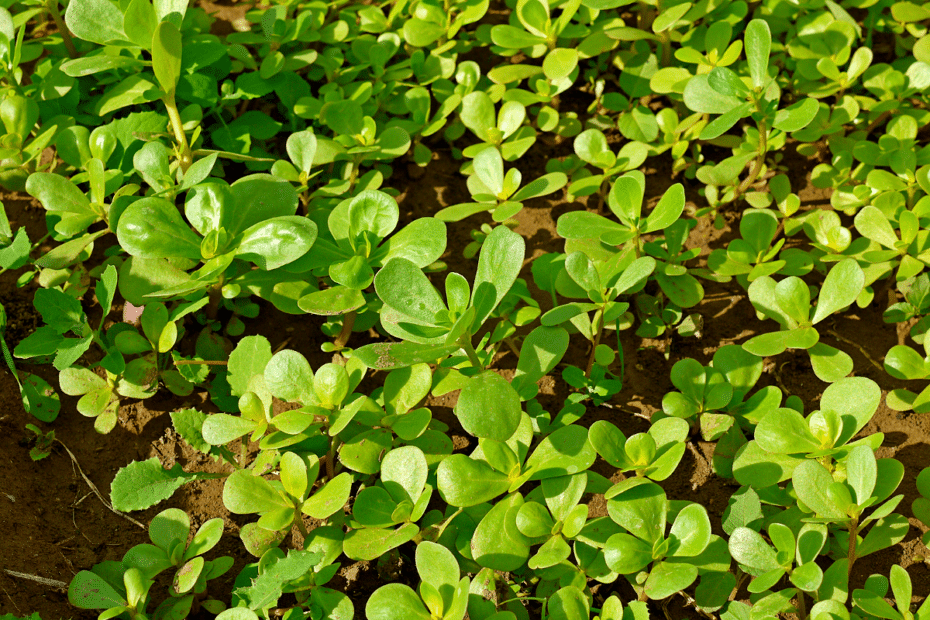Purslane, a fast-growing weed, can be quite troublesome for gardeners and lawn enthusiasts as it tends to quickly invade their green spaces. In this article, we will guide you on effective ways to identify, prevent, and control these unwanted purslane infestations and secure a healthy environment for your beloved plants.
Contenus de la page
Recognizing purslane
To effectively manage purslane in your garden, first, you must be able to recognize it. Purslane is characterized by its smooth, reddish-brown stems, which can extend up to 12 inches in length.
The plant’s stems, which stay close to the ground, are adorned with leaves that resemble those of succulents, lending it a somewhat fleshy look.
This weed has a prolonged blooming season from June to November, during which it produces yellow flowers.
How to stop the rapid growth of purslane in your yard and garden
Maintaining a healthy lawn and garden: the best defense against purslane
Protecting your outdoor space from invading purslane starts with keeping your soil nourished, aerated, and well-drained. These conditions enable the growth of healthy plant life that can compete with intrusive weeds.
Moreover, regular inspections of your garden help you detect early signs of emerging purslane patches before they manifest into full-blown infestations.
Consistent yard maintenance and quick action are key to dealing with this fast-growing weed.
Promoting soil health: A strategy to outcompete purslane
- Add organic matter like compost or aged manure regularly to enhance the nutrition content of your soil.
- Aerate compacted soil using special tools or techniques like core aeration, liquid aeration, or manual loosening.
- Implement proper drainage solutions such as grading or installing French drains where standing water is an issue.
Detection and control of emerging purslane patches
Thankfully, with early detection, there are numerous methods available to remove and manage purslane growth in your lawn and garden.
Hand-pulling method: manual removal of purslane
Hand-pulling is a simple yet efficient way to combat purslane when it has not yet spread extensively. Be sure to remove entire roots and stem fragments, as even small pieces can regrow into new plants. Remember, consistency is critical when using this method.
Recheck the spot every few days to ensure no broken stems are left behind that could lead to another outbreak.
Natural predators: attracting purslane sawfly
The purslane sawfly, a natural predator of purslane, feeds on its leaves and weakens the plant. Introducing these beneficial insects in your garden can help control existing weed infestations while preventing their recurrence.
Creating competitive environments for plant growth
By cultivating a competitive environment where desirable plants thrive, you can limit the opportunities for invasive weeds like purslane to establish themselves.
Choose vegetation native to your area that will adapt well to the soil and climatic conditions of your garden site.
- Opt for groundcover plants with dense foliage to inhibit weed seedling growth and compete for space and resources. Examples include creeping thyme, mondo grass, or vincas.
- Use taller companion plants, trees, or shrubs that cast shade onto potential purslane-infested areas, thus withholding the sunlight they require for growth.
Other effective control measures to prevent purslane invasion
In addition to the aforementioned strategies, you may also explore other preventive measures to keep your lawn and garden free from fast-growing purslane.
Mulching: hinder weed growth
Mulching is an effective way to suppress stubborn weeds by creating a barrier that restricts sunlight and disrupts germination. Organic mulches such as straw, wood chips, or shredded bark decompose over time, benefiting your soil as well.
Chemical Controls: utilizing herbicides
As a last resort, chemical herbicides may be employed to control severe purslane infestations. Pre-emergent herbicides work on young weed seedlings, hindering their development before they surface from the ground. Post-emergent herbicides target established weeds that have already emerged.
Ensure you carefully read and follow label instructions while handling these chemicals to avoid damaging nearby desirable plants.
Taking decisive action against purslane: key takeaways
In conclusion, continuity in yard maintenance practices and early intervention remain fundamental when dealing with fast-growing purslane invasions. Make sure your lawn and garden are healthy by promoting soil health, detecting and addressing emerging patches, adopting suitable control measures, and creating competitive environments for preferred plant species.
With determination and consistency, you can protect your outdoor space from unwelcome purslane infestations, preserving its beauty and success.


